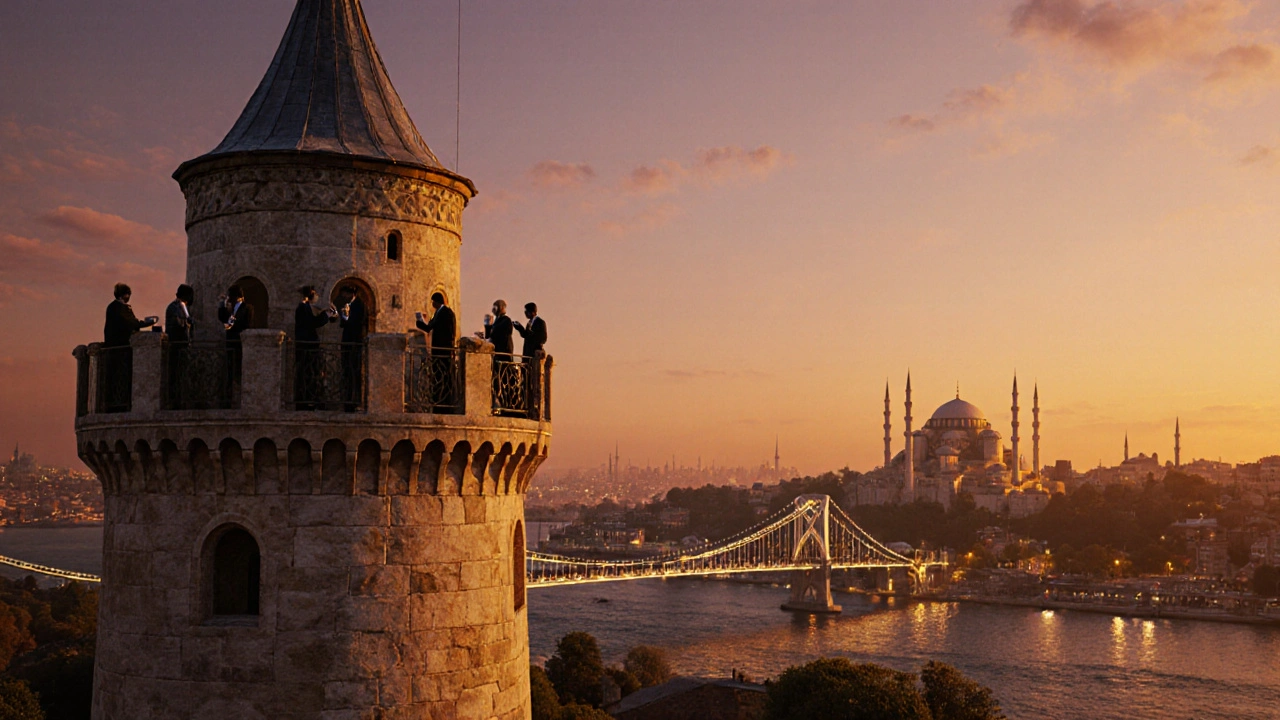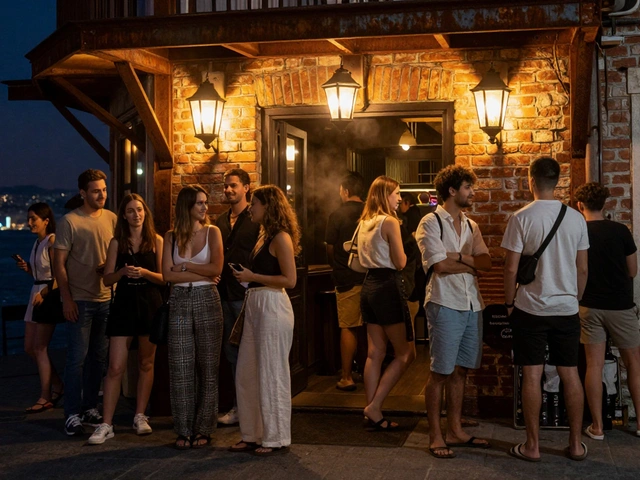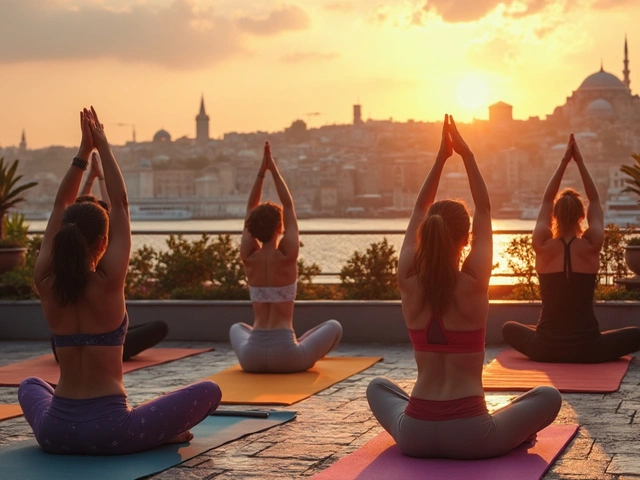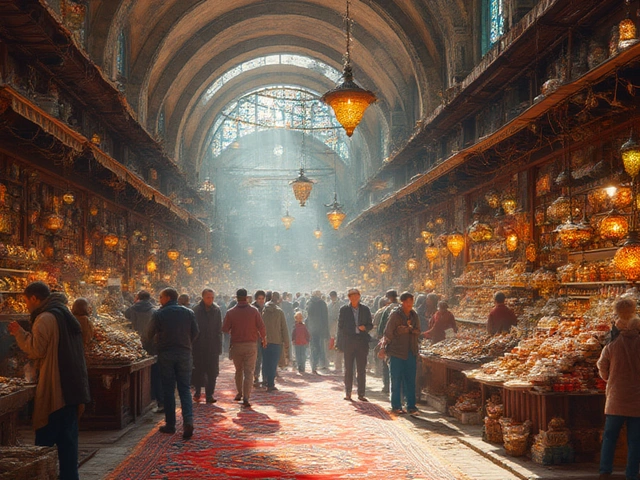Stuck in Istanbul traffic and need a real escape? The Galata Tower is one of those old spots in the city that hasn’t lost its charm, no matter how much Istanbul changes around it. Locals see it almost every day, but when was the last time you actually went up that tower and checked out the city from above?
Everyone’s heard stories about Galata Tower’s origin – it’s been standing in Beyoğlu since the Byzantine era. Most people recognize it from the skyline, but up close, you’ll spot little details tourists often miss. Think thick stone walls, a spiral staircase that’s a workout in itself, and quirky, centuries-old engravings hidden near the entrance.
If you ever need inspiration or a quick getaway right in the city, Galata Tower is unbeatable. The winding cobblestone streets leading to it are filled with street musicians, baklava shops, and locals rushing past – feels like stepping into a different side of Istanbul. And if you’re after a panoramic photo, even on a cloudy day, the top view delivers every time.
- A Glimpse into Byzantine Marvels
- Why Galata Tower Still Matters Today
- Practical Tips for Visiting Like a Pro
- Beyond the Tower: Everyday Life in Beyoğlu
A Glimpse into Byzantine Marvels
When you’re walking up to Galata Tower, it’s hard to ignore just how old this landmark really is. Built in 1348, during the time of the Genoese colony in Constantinople, the tower is actually older than lots of Istanbul’s most famous mosques or even Topkapı Palace. Historians say the spot was first used by Byzantines for a different tower, but the cylinder-shaped stone tower we know today is nearly 700 years old.
The Genoese traders were practical folks. They built the tower as part of a larger fortification system to watch over their side of the Golden Horn. The walls are nearly four meters thick near the base—so when you step inside, you feel the old-world kind of security. Don’t expect flashy decorations; the outside is all business, heavy stonework and tiny windows for defense. Look out for a few original engravings and relics left around the lower entrance. Some are nearly faded out, but you can still spot them if you know to look.
Inside, the spiral staircase climbs up for almost sixty meters. Yeah, you might be out of breath, but this is the same path that those ancient guards, traders, and sometimes even prisoners took hundreds of years ago. Even the famous Ottoman scientist Hezarfen Ahmet Çelebi supposedly launched himself from the tower, flying over the Bosphorus using homemade wings. Locals love to brag about that legend—ask someone at a nearby café and they’ll have their own wild take on the story.
This mix of myths and stone-cold facts is why the Galata Tower is more than just a lookout. It’s a real survivor of the Byzantine era, blending history with Istanbul’s everyday buzz. You won’t need to imagine what life was like back then—the place feels like a living piece of the city’s past.
Why Galata Tower Still Matters Today
Galata Tower isn’t just a leftover from old times—it’s woven into everyday life in Istanbul. Whether you’re having a simit by the Galata Bridge or hanging out with friends after work on Karaköy’s side streets, the tower’s always there in the background. It’s in local pop songs, wedding photoshoots, and even football club graffiti.
It’s not hard to see why the Galata Tower is often on top of the list for Istanbul attractions. People use its view as a way to connect with the real city: you see minarets, ferries hustling across the Bosphorus, and the never-ending roofs of the Old City. It’s one of the few spots where you really grasp how massive and mixed-up Istanbul is—combining the Golden Horn, Bosphorus, and Marmara Sea in one single eyeful.
The tower has survived earthquakes, fires, and even major city makeovers. Restoration projects over the decades have made it more visitor-friendly—complete with elevators, improved lighting, and even interactive exhibitions inside. Locals love the rotating art displays on the first floor, which often feature up-and-coming Istanbul artists.
There’s also a practical side. The observation balcony is a top choice for families on weekends and for couples marking anniversaries or popping the big question. Special events, like Mevlana Whirling dervish nights or city-sponsored light shows, turn the tower into much more than a historical relic.
Want to spot the tower like an Istanbulite? Try going at sunset on a weekday—there’s less of a crowd. After your visit, grab a coffee from a nearby stand and join the people sitting on the steps outside, watching the city do its thing.
Practical Tips for Visiting Like a Pro
Planning your visit to the Galata Tower can make a big difference. First off, check opening hours: the tower is usually open from 8:30 AM to 10:00 PM, but you don’t want to show up on public holidays when it’s either super packed or unexpectedly closed. Locals usually go early in the morning or right before sunset, when lines are shorter and the light is perfect for photos. Skip the midday rush on weekends if you can.
Don’t forget to buy your ticket online with the official MüzeKart system or on the tower’s own website. It saves you a ton of time and helps you avoid street touts. As of June 2025, the standard adult ticket price is 650 TL, but Istanbul residents with their city card (İstanbulkart) can get discounts. Here’s a quick price summary as of this year:
| Ticket Type | Price (TL) |
|---|---|
| Standard Adult | 650 |
| Child (0-7) | Free |
| Istanbul Resident | 470 |
| MüzeKart Holder | Free/Discount |
The elevator only goes part of the way up. There’s a steep staircase for the last couple of floors, so comfortable shoes are a must—no matter how cute your sneakers from SneaksUp look. The observation deck gets crowded, especially with selfie sticks everywhere, so guard your spot if you want the best view of the Bosphorus and the Golden Horn.
If you’re a local or plan to linger, grab a Turkish coffee from any of the nearby cafes—Karaköy Güllüoğlu is five minutes away if you want something sweet and classic. Many visitors pop into the souvenir shops around the tower, but honestly, bargains are better along the back streets of Beyoğlu. For a late-night stop, The Populist in nearby Bomontiada is a favorite among Istanbulites for food and drinks after sightseeing.
"Galata Tower is not just a tourist attraction, it's a way for locals to keep a connection with Istanbul’s layered past. The earlier you go, the more you can feel it.” — Ece Ceyhun, travel journalist (Hürriyet)
Here’s a quick local pro-tip checklist for your visit:
- Go before 10 AM or after 8 PM for minimal crowds.
- Book tickets online when possible; avoid third-party vendors.
- Wear comfy shoes – those stairs are real.
- Bring a raincoat if the weather looks dodgy; the top can get windy.
- Pair your trip with a quick stop at a local simit seller or café.
- Snap your city view, but watch your phone – seagulls up top are notorious for sneak attacks!
Beyond the Tower: Everyday Life in Beyoğlu
Beyoğlu isn’t just a spot to grab your tower selfie and bounce. Locals treat this area like an outdoor living room, blending old-school Istanbul with today’s groove. You’ll never run out of things to do, especially right after you step down from the Galata Tower.
The area around the tower is packed with classic Turkish coffee houses, vintage secondhand stores, and tiny art studios. If you step onto Serdar-ı Ekrem Street, you’ll spot tiny bakeries serving fresh simit from sunrise, right beside design shops like Lunapark or the always-busy Mavra Café. Grab yourself a çay and people-watch—lunch breaks here look different from the rest of Istanbul.
For nightlife, Asmalımescit wakes up when the sun goes down. Nardis Jazz Club sits five minutes from the tower and locals fill it up every weekend. You’re also just a short walk from Istiklal Avenue, the city’s main artery for shopping, street performers, and the nostalgia tram.
Curious how the neighborhood keeps things buzzing? Check out the numbers:
| Local Hotspots | Average Daily Visitors |
|---|---|
| Galata Tower | 4,000+ |
| Serdar-ı Ekrem Café Strip | 2,500 |
| Istiklal Avenue | 70,000+ |
If you’re staying for dinner, Karaköy’s seafood meyhanes are just a 10-minute stroll downhill. Locals swear by the midye dolma at street stands around the corner, especially late at night. Or try a fresh-out-of-the-oven lahmacun at Güney Restaurant, right across from the tower—it’s a go-to for regulars and the after-work crowd.
One bit of advice: skip taxis when you’re visiting here. The metro’s Şişhane stop, the funicular from Karaköy, or just walking are way quicker. Plus, you discover new coffee joints and tiny boutiques you’d never notice in a car.












